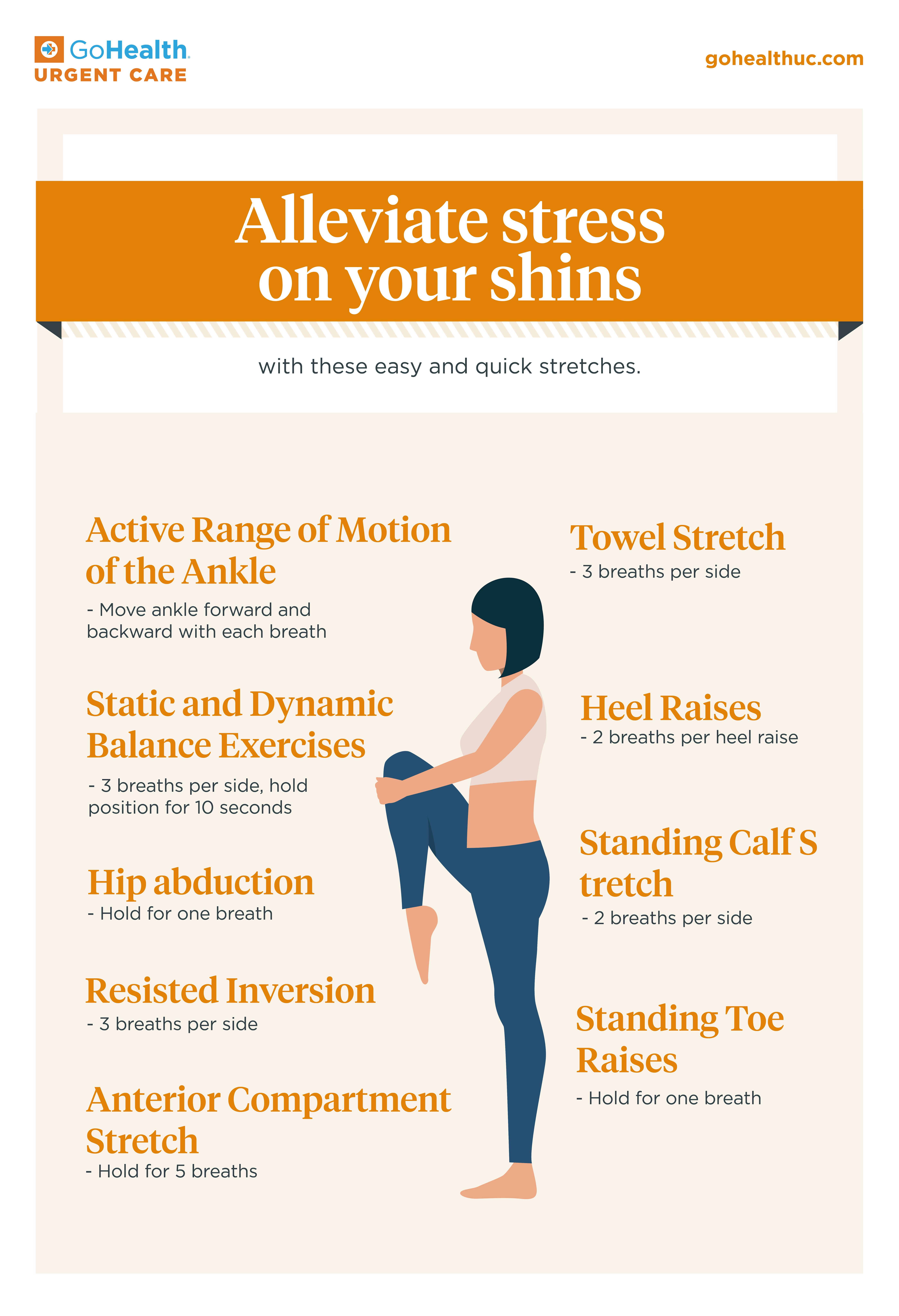Shin splint stretches for prevention and treatment
If you’ve ever wondered whether you should be doing shin splint stretches, consider the following scenario and tips for how to recover from shin splints.
Whew! You’re finally done with that brutal three-mile run. As you walk up the driveway, sweaty and out of breath, you feel shooting pains in your lower legs. You reach down and touch your shin. It hurts like a bruise. What gives?
You might have shin splints. Also known by the medical term medial tibial stress syndrome, shin splints involve sharp, shooting pain in the lower legs. They’re extremely common sports injuries in runners — especially newbies. This type of injury is caused by continuous stress on the lower leg muscles, which leads to inflammation where the muscles attach to the shin bone.
This injury is most common among athletes as a result of repeated stress on the lower legs. However, anyone can experience shin splints.
Common warning signs of shin splints include:
- Soreness in the lower leg.
- Tenderness over an area that is at least one inch in length.
- Aching, throbbing pain in the front lower leg.
- At first, pain occurs only after running; but can develop while running.
If you think you might have shin splints, a medical professional can perform an X-ray to confirm the diagnosis and rule out other potential causes of leg pain. Shin splint recovery usually involves a combination of rest, anti-inflammatory medicine, icing and shin splint exercises. Getting an assessment from a running professional for new shoes may also be in order.

Shin splint stretches and exercises for relief
Shin splints are a pain in the lower leg typically caused by exercise. Lower leg stretches and heel walking can help you manage your shin splints and get you back on track. Here are a few ways to stretch shin splints:
Standing calf stretch
- Stand facing a wall with your hands on the wall at eye level.
- Keep your injured leg back with your heel on the floor.
- Keep the other leg forward with the knee bent.
- Turn your back foot slightly inward, as if you were pigeon-toed.
- Slowly lean into the wall until you feel a stretch in the back of your calf. Hold this stretch for 15 to 30 seconds.
- Return to the starting position. Repeat three times. Do this exercise several times each day.
Standing toe raise
- Stand with your feet flat on the floor.
- Rock back onto your heels and lift your toes off the floor.
- Hold for five seconds and then put your toes back on the floor. Do two sets of 15.
Towel stretch
- Sit on a hard surface with your injured leg stretched out in front of you.
- Loop a towel around your toes and the ball of your foot and pull the towel toward your body, keeping your leg straight.
- Hold this position for 15 to 30 seconds and then relax. Repeat three times.
Anterior compartment stretch
- Stand sideways next to a wall or chair with your injured leg further from the wall or chair.
- Rest one hand on the wall or chair for balance.
- Bend the knee of your injured leg and lean forward to grab the front of your foot.
- Bend the front of the foot toward your heel. You should feel a stretch in the front of your shin.
- Hold for 15 to 30 seconds. Repeat three times.
Kneeling shin stretch
- Get into a tabletop position with your hands and knees on the ground. Place a foam roller under the tops of your feet.
- To increase the stretch, sit back on your hips toward your heels. You can sit back as far as you want, depending on the degree of stretch you like.
- Hold this stretch for 30 to 60 seconds and then return to all fours.
Seated shin stretch
- Sit in a chair toward the edge with your ankles in line with your knees.
- Take your left ankle and place it on top of your right knee.
- Place your right hand on top of your left foot, along your toe knuckles. Gently press down on the foot to straighten out your ankle and feel a comfortable stretch in your shin and foot.
- Hold your stretch for 10 to 15 seconds and then relax. Repeat this five times on both feet.
Achilles tendon standing stretch
- Stand near a wall approximately an arm's length away.
- Lean forward and place both hands on the wall, shoulder-width apart.
- Extend one of your feet back and place the heel flat on the floor, keeping the other foot closer to the wall.
- Learn forward and press down on the back heel with your knee bent slightly.
- Lower your hips slightly to increase the stretch. Avoid bending at the waist.
- Hold this stretch for 30 seconds and repeat one to four times per leg.
Shin splint recovery process
Shin splints are annoying but not permanent. Proper shin splint treatment, including rest, changing exercise regimens, shin splint stretches and improving your footwear, are essential to promote recovery. You should call your doctor if your shin splint pain does not go away after a few weeks of rest and practicing stretches for shin splints.
Shin splint prevention tips
You may not be able to prevent shin splints, but there are some ways that you can minimize your risk of developing them or making them worse. These include:
- Choose supportive athletic shoes and replace running shoes every 300 miles. Consider orthotic inserts to support your arches. Both of these things can fit correctly to your feet at a running store.
- Increase physical activity, especially running, slowly rather than suddenly jumping into a new routine.
- Stretch your muscles before exercising to help warm them up and prevent overuse injuries.
- Run and exercise on softer surfaces, like grass or a gym mat, rather than concrete.
- If you run a lot, consider switching up your exercise routine with other low-impact, cross-training options like swimming. This helps provide time for muscle recovery.
- Never push through the pain. Instead, reduce your activity level and take a rest whenever needed.
If shin splints don’t seem to be improving with rest and stretching, consider visiting a healthcare provider for further evaluation.
Other leg issues with similar pain
While shin splints are common, there might be other causes of lower leg pain that create similar symptoms. Some of these include:
- Stress fractures: These are commonly caused by repetitive, excessive loads to the bone when paired with inadequate rest.
- Fractures: Fractures in the lower leg can occur as a result of endurance and contact sports like soccer.
- Arthritis: This is a painful condition that typically affects the joints. It can be caused by overuse or autoimmune disease.
- Compartment syndrome: During exercise, the muscles in the lower front of the legs swell with blood, but there’s a limit on how much expansion can occur. However, some people have no expansion room and experience pain.
- Venous thrombosis: While this can be rare. Thrombosis is the formation of a blood clot causing the blockage of blood circulation in a vein. A thrombosis can cause tenderness and pain.
- Nerve entrapments: This occurs when major nerves around the lower leg or foot are trapped by muscle contractions and squeezed, which can be painful.
The best way to determine the cause of your lower leg pain is to have your symptoms examined by your doctor.
Shin splints FAQs
Here are some common questions about shin splints.
What is the fastest way to heal shin splints?
Shin splints can be healed by rest, anti-inflammatory medications, applying ice to the affected area and wearing the right shoes when running. Massage can also help relieve some of the pain.
How long does it take for shin splints to heal?
Shin splints typically take two to four weeks to heal if you limit high-impact exercise and rest.
Should you massage shin splints?
Yes, massage is a shin splint treatment that can help relieve shin splints by relaxing the muscles around the shin, improving blood flow and helping reduce inflammation.
Can you just push through shin splints?
It is best not to push through shin splints, as the pain and inflammation can worsen. Instead, take a few days or weeks off to resume activity pain-free.
What do shin splints feel like?
Shin splints involve pain or soreness on the inner side of the shin bone. It typically starts during exercise and may stop once you quit exercising. But the pain can become chronic if you do not take some time to rest.
Visit your nearest urgent care for any running or shin splint injuries
Shin splints are painful running injuries that can also occur with different types of exercise.
Remember: never try to run through the pain because it can worsen and potentially lead to a stress fracture. When returning to a running program for shin splint recovery, gradually increase your mileage. Starting too strong can risk reinjuring the area. Shin splint stretches should also be a regular part of your routine to support recovery.
If you have severe leg pain that doesn’t improve with time, find the urgent care location nearest you to save your spot online or simply walk in. Urgent care through our healthcare partners can provide recommendations and referrals if needed to help relieve your pain.
References:
- https://www.mayoclinic.org/diseases-conditions/shin-splints/symptoms-causes/syc-20354105
- https://www.hopkinsmedicine.org/health/conditions-and-diseases/shin-splints
- https://www.mayoclinic.org/symptoms/leg-pain/basics/causes/sym-20050784
- https://medlineplus.gov/ency/patientinstructions/000654.htm
Written by Sarah Thebarge, Physician Assistant


